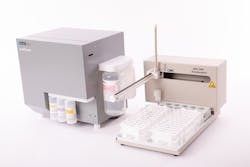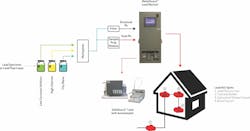Lead in Drinking Water Contamination: A Canary in the Mine
About the author:
Rick Bacon is CEO of Aqua Metrology Systems. Bacon can be reached at [email protected] or 408.523.1900.
Many cities in the U.S. have a lead contamination problem in their drinking water. This represents a serious threat to human health, particularly that of young children for whom it can be the cause of irreversible brain damage.
Recent reports of the lead contamination crisis in Newark, New Jersey, and likely the most well-known lead contamination story of Flint, Michigan, in 2015, have revealed that traditional lead monitoring programs lack the ability to: measure the presence of all forms of lead; capture unpredictable changes in water quality that result in lead corrosion; and report the contamination risk before the water is delivered to the customer. Instead, utilities monitor for lead in drinking water by infrequently sampling only a small number of domestic points of use, and then wait for lab results by which time the damage has been done. As has so often been the case, it is the elevated levels of lead in children’s blood that triggers an alarm. This is an inefficient and reactive method of addressing the problem.
The drinking water crisis in Flint brought national attention to the fact that many cities struggle to ensure safe water due to lack of funding and aging infrastructure. However, in Newark, the city’s lack of real-time, continuous monitoring of lead levels further exacerbated the problem.
While Newark gave out more than 40,000 water filters — even going door-to-door to reach families with lead service lines — unfortunately, the city-distributed water filters failed to address acute lead contamination as samples showed that filtered drinking water had lead levels exceeding 15 parts per billion (ppb), the current federal action level.
Filters can indeed remove lead on an ongoing basis, but when there is a sudden spike in lead in the water, these filters are overwhelmed quickly. Because the distribution system is not monitored in real time and continuously, when that spike happens, filters are rendered ineffective. Even worse, communities and their utilities are not even aware of this until the results of lab testing or children’s blood test analyses become available possibly weeks or even months after their exposure.
The Need for a Better Solution
The need for a technology that monitors water quality frequently and in real time, with quick data analysis and results, is abundantly clear.
“It’s time that our communities and public utilities be given an option to act and prevent, rather than react,” said Dr. Vlad Dozortsev, development manager of Trace Metal Instrumentation, who also leads the Aqua Metrology Systems (AMS) Innovation Center in New Jersey. AMS is dedicated to the development and commercialization of solutions for reducing the risk of lead contamination by providing water systems and communities real-time lead monitoring and preventative solutions to protect public health.
“Testing children for lead levels is important and should be done with more frequency,“ Dozortsev added, “but it is still an action that is taken after the problem has already occurred. We should not be using children to serve as detectors of the problem, and we should not be waiting for their test results to alert about elevated lead levels in our drinking water.”
Under the U.S. EPA’s new proposals (See box above), systems are still only required to conduct monitoring every six months at a limited number of customer taps. The new proposals do not go far enough. Put simply, infrequent sampling of homes likely will not capture the moment when corrosion occurs in a distribution system, and if it does, the consumer likely will already have been exposed.
While AMS applauds any efforts to reduce lead in drinking water, Dozortsev and other leaders in the organization strongly believe the focus and dollars should be put toward prevention instead of increased monitoring.
“Current regulations and even the new proposed regulations are still based on traditional lab-based analyses that begin with infrequent sampling and end with results that are provided many days later by which time the damage has been done,” Dozortsev said.
New Technology
AMS has developed a new on-site risk analysis and monitoring system called MetalGuard Lead Alert!. Consumers, water treatment plants and at-risk sites may use this system to be made aware of an increase in the risk of lead poisoning so they can take timely actions to avoid exposure. This solution offers communities real-time, continuous and dynamic water quality assessment of the presence of total lead in buildings or zones exposed to events that are the cause of acute lead contamination, in an aim to reduce the risk of exposure. Other benefits to this technology include fully automated, unattended operation; accuracy down to 1 ppb; 30-minute results for dissolved lead analysis; and 1-hour results for total lead analysis. The system can log data, generate reports and archive results as well. AMS will deploy and full-scale pilot the technology in 2020.
Additionally, the SafeGuard Lead automated lead analyzer can be used in conjunction with or separately from the monitoring system for rapid low-cost analysis. The analyzer, which would work well in homes,
daycares or schools and other at-risk sites for lead contamination, can return results on total lead contamination down to 1 ppb in just 30 minutes after loading a sample.
|
New EPA Proposals The U.S. Environmental Protection Agency (EPA) recently proposed regulatory revisions to the National Primary Drinking Water Regulation (NPDWR) for lead and copper under the authority of the Safe Drinking Water Act (SDWA). The new proposals continue the push for replacing lead water service lines; requireing communities to inventory lead lines; providing corrosion control treatment; following new and improved sampling procedures; and encouraging an increase in communications with residents when water tests at higher than the action level of 15 ppb. The plan also sets a new “lead trigger level” of 10 ppb, which would require water systems to take actions working toward lead reduction at that point. The plan calls for an annual letter to be issued to customers with lead service lines or unknown material, to further promote line replacement, and will also notify these customers of other potential options, including point-of-use lead removal devices. The Lisle, Illinois-based Water Quality Association (WQA), whose membership is comprised of equipment manufacturers, suppliers, dealers and distributors of water quality improvement products and services, announced its support of the new EPA proposals and encouraged its members and the public to submit comments at regulations.gov. “WQA applauds efforts to reduce lead in public drinking water wherever possible while standing ready with immediate solutions,” the association announced in a statement. |
Real-World Application
A utility could use this system to create an environment where every 30 minutes water in a distribution system is monitored long before it gets to the consumer. This water passes over lead components, including service lines, water pipes, pieces of solder, and brass fittings — all of which are sources of lead contamination. As soon as the water chemistry changes — any element of it — that would provoke corrosion in these components, it would send an alarm. It takes two or three days for water to get from the distribution system to the consumer’s drinking tap, which is plenty of time for action for these alarms.
Once the system has identified a risk, testing can begin frequently in homes or other at-risk sites to confirm whether or not the risk has materialized. If it has, testing can continue frequently until the risk has passed and the community knows the water is safe to drink again.
“This is a totally new way of predicting deterioration of water quality,” Dozortsev said. “The system uses risk analysis, artificial intelligence and predictive analytics to actually warn people ahead of the contaminated water reaching them. In this way, our system acts as a ‘canary in the mine’ to warn of treatment system failures that put at risk human health but takes action to protect the canary.”
The monitoring system and the analyzer also offer municipalities and utilities peace of mind, as they no longer have the burden of manually monitoring increasingly sophisticated treatment systems for which they struggle to recruit and retain the skilled labor required for their supervision and maintenance. They also offer a less expensive alternative to substantial capital investment.
“EPA estimates for lead service line replacement are approximately $30 billion,” Dozortsev said. “Until this investment is made, if ever, consumers will continue to be exposed to the risk of lead poisoning. MetalGuard Lead Alert offers an affordable and reliable real-time lead corrosion risk management system to help reduce the risk of consumers’ exposure to lead contamination.”

